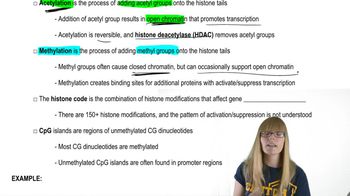Table of contents
- 1. Introduction to Genetics51m
- 2. Mendel's Laws of Inheritance3h 37m
- 3. Extensions to Mendelian Inheritance2h 41m
- 4. Genetic Mapping and Linkage2h 28m
- 5. Genetics of Bacteria and Viruses1h 21m
- 6. Chromosomal Variation1h 48m
- 7. DNA and Chromosome Structure56m
- 8. DNA Replication1h 10m
- 9. Mitosis and Meiosis1h 34m
- 10. Transcription1h 0m
- 11. Translation58m
- 12. Gene Regulation in Prokaryotes1h 19m
- 13. Gene Regulation in Eukaryotes44m
- 14. Genetic Control of Development44m
- 15. Genomes and Genomics1h 50m
- 16. Transposable Elements47m
- 17. Mutation, Repair, and Recombination1h 6m
- 18. Molecular Genetic Tools19m
- 19. Cancer Genetics29m
- 20. Quantitative Genetics1h 26m
- 21. Population Genetics50m
- 22. Evolutionary Genetics29m
13. Gene Regulation in Eukaryotes
Epigenetics, Chromatin Modifications, and Regulation
Problem 10b
Textbook Question
How do microRNAs regulate epigenetic mechanisms during development?
 Verified step by step guidance
Verified step by step guidance1
Understand that microRNAs (miRNAs) are small non-coding RNA molecules that play a crucial role in regulating gene expression post-transcriptionally.
Recognize that miRNAs can influence epigenetic mechanisms by targeting messenger RNAs (mRNAs) for degradation or by inhibiting their translation, thus affecting the expression of genes involved in epigenetic regulation.
Explore how miRNAs can modulate the expression of genes encoding for proteins involved in DNA methylation, histone modification, and chromatin remodeling, which are key epigenetic processes.
Consider the role of miRNAs in developmental processes, where they can fine-tune the expression of genes necessary for cell differentiation and organ development by interacting with epigenetic regulators.
Investigate specific examples where miRNAs have been shown to regulate epigenetic changes during development, such as their involvement in stem cell differentiation or in the development of specific tissues or organs.
Recommended similar problem, with video answer:
 Verified Solution
Verified SolutionThis video solution was recommended by our tutors as helpful for the problem above
Video duration:
1mPlay a video:
Was this helpful?
Key Concepts
Here are the essential concepts you must grasp in order to answer the question correctly.
MicroRNAs
MicroRNAs (miRNAs) are small, non-coding RNA molecules that play a crucial role in regulating gene expression. They bind to complementary sequences on target messenger RNAs (mRNAs), leading to mRNA degradation or inhibition of translation. This regulation is vital during development, as it helps control the timing and level of protein production necessary for proper cellular functions and differentiation.
Recommended video:
Guided course

RNA Interference
Epigenetic Mechanisms
Epigenetic mechanisms refer to heritable changes in gene expression that do not involve alterations to the underlying DNA sequence. These changes can be mediated by chemical modifications, such as DNA methylation and histone modification, which influence chromatin structure and accessibility. During development, epigenetic regulation is essential for cell identity and the orchestration of developmental processes.
Recommended video:
Guided course

Chromatin
Developmental Regulation
Developmental regulation encompasses the processes that control the growth and differentiation of cells into various tissues and organs during an organism's development. This regulation is tightly coordinated and involves various signaling pathways, transcription factors, and regulatory RNAs, including miRNAs. Understanding how miRNAs interact with epigenetic mechanisms provides insight into the complex regulatory networks that govern development.
Recommended video:
Guided course

Regulation





